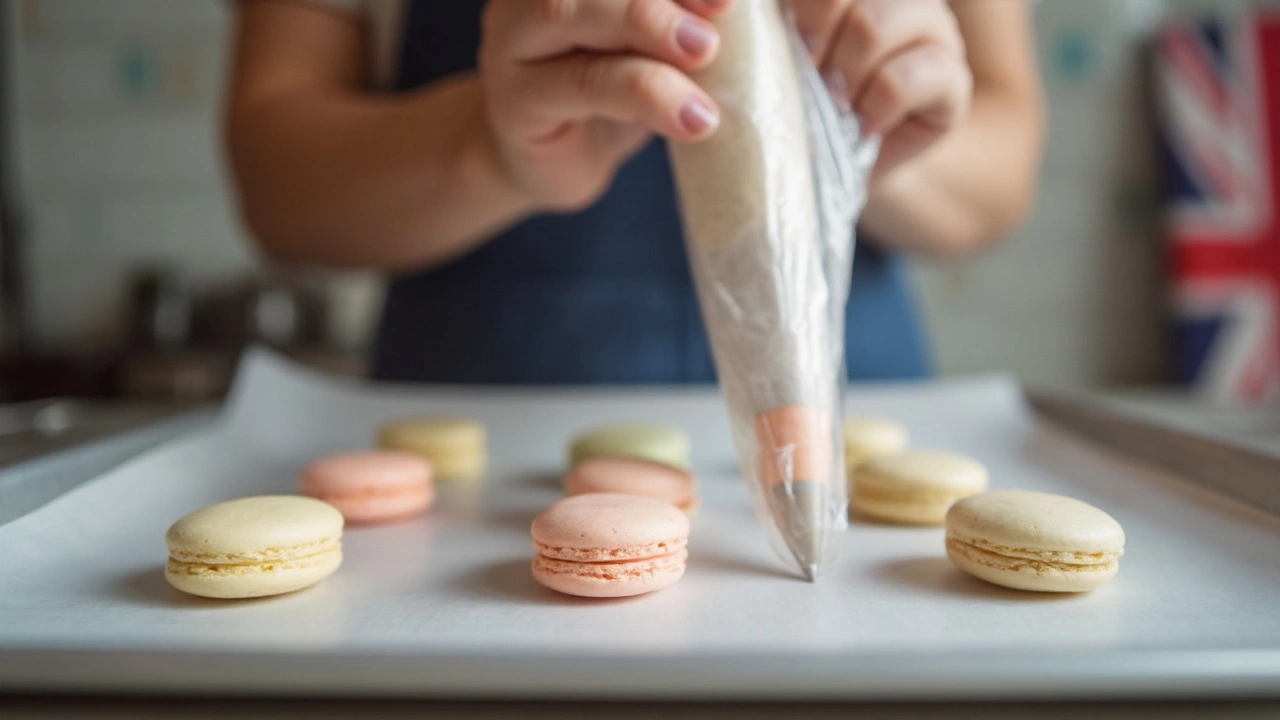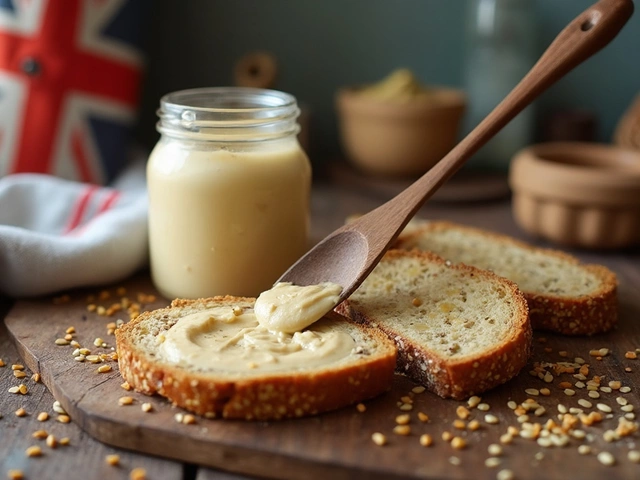
If your macarons keep exploding in the oven, you’re not alone. Lots of home bakers face this mess, even after following recipes perfectly. Cracked, burst tops aren’t random bad luck—there’s always a reason behind each dramatic blowout.
First, macarons are super sensitive to tiny changes in the process. Even one small slip, like overmixing the batter or skipping the resting phase, can send your shells over the edge. Many times, it’s all about the consistency—if the batter is too thick or too runny, expect trouble. Get that sticky, lava-like texture right in the middle and you’re halfway there.
- The Science Behind Macaron Shells
- Most Common Causes of Macaron Explosions
- Fixing Your Technique: Step-by-Step Solutions
- Pro Tips for Smooth, Intact Macarons
The Science Behind Macaron Shells
Macarons look simple, but there’s a lot going on inside—and that's exactly why they explode if anything is off. When you mix almond flour, powdered sugar, and whipped egg whites, you’re making a batter that acts like a balloon. The flowing texture lets air bubbles form. Those bubbles give macarons their height but, if not handled right, they cause bursts instead of those smooth, crisp tops everyone loves.
The secret is the meringue. Egg whites trap air when whipped, but too much or too little whipping changes how the macaron rises. Under-whipped? The shell stays flat and gummy. Over-whipped? The shell is fragile and cracks. That’s why strict timing and careful folding matter so much.
This process is crazy sensitive to humidity and heat. High humidity makes the shells too soft; low humidity makes them dry out and crack. Even your oven racks, door seals, and temperature settings can throw things off. If the oven is too hot, the outer shell forms too fast and the middles explode out. Too cool and they dry out before forming a proper shell.
- Whipping egg whites creates tiny air bubbles for structure.
- Sifting almond flour and sugar removes lumps, meaning smoother shells.
- Resting unbaked shells lets a skin form, which minimizes cracks and blowouts.
- Baking at the right temperature ensures even rise—no sudden bursts.
Check out this at-a-glance reference for common factors affecting macaron shells:
| Factor | Ideal Condition | What Can Go Wrong |
|---|---|---|
| Egg white whipping | Stiff, but glossy peaks | Soft peaks collapse; over-whipped cracks |
| Batter consistency | Lava-like, flows in ribbons | Too thick bursts; too runny spreads |
| Oven temperature | 145–150°C (290–300°F) | Too hot — shells explode Too cool — shells shrink |
| Resting time | 20–40 min (until skin forms) | No resting — shells burst or crack |
If you want to avoid the dreaded macaron explosion, understanding these basics can save you hours of wasted effort—not to mention a whole lot of almond flour.
Most Common Causes of Macaron Explosions
Watching your macarons blow up in the oven is the kind of headache no baker needs. The reasons are usually pretty simple and easy to fix once you spot them. Here’s what really makes those shells burst or crack.
- Batter Consistency: Overmixing or undermixing the batter is the #1 culprit. If it flows like pancake batter, it’s too runny, and if it’s stiff and clumps, it’s under-mixed. Either way, this messes with how shells settle and rise—leading to big cracks or full-on explosions.
- Oven Temperature: Surprising but true: even a 5°C (about 10°F) difference can wreck your batch. If the oven’s too hot, the shells get a fast, crazy rise and explode; too cool, and they never set right. Always check your oven with an oven thermometer—built-in settings can be way off.
- No Rest Time: Macaron shells need a thin skin to form before baking. If you skip or shorten the rest time, the surface stays sticky and pops open in the oven’s heat. (Humidity makes this worse—sometimes you need to wait twice as long, especially in summer.)
- Uneven Piping: If you pipe some shells thicker than others, the thick ones will dry slower and burst while the thinnest go flat. Keep everything as even as possible—it really does matter.
- Baking Sheet Choices: Cheap, thin baking sheets overheat easily and cause the bottoms to pop. Stick with heavy, double-layered sheets or use two stacked together for a steady bake.
Check out how these issues can affect your macarons in this quick reference table:
| Problem | What Happens | Common Solution |
|---|---|---|
| Batter too runny | Shells flatten, burst, or form odd shapes | Stop mixing earlier; test the lava flow |
| Oven too hot | Shells rise too fast and crack | Lower oven temp by 10°C/20°F |
| Skipped rest | Surface explodes as it bakes | Let macarons rest 30-45 mins, longer if humid |
So when you’re troubleshooting macaron explosion issues, start with these basics. Get these right and you’ll see way less cracking, no matter how many trays you bake.

Fixing Your Technique: Step-by-Step Solutions
Alright, let’s sort out what really works when your macaron shells keep bursting. No baking magic here—just real fixes that help every time.
- Watch Your Batter Consistency: Too thick or too loose, and your shells will puff and crack. Aim for a consistency that slowly flows off your spatula and folds back into itself after counting to ten. If it spreads like pancake batter, you’ve gone too far. If it stacks up on itself, it needs just a couple more folds.
- Sift, Don’t Skip: Always sift your almond flour and powdered sugar together, twice. It gets rid of lumps and helps the shells bake evenly.
- Pipe Like a Pro: When piping, hold the bag straight up and stop squeezing as soon as the circle forms. Tap the tray a few times on the counter to pop bubbles. This prevents air pockets that could make the shells explode later.
- Rest Before Baking: This is the big one. After piping, let your trays sit for at least 30 minutes until the surface feels dry—sometimes longer if your kitchen is humid. If the shell’s not dry to the touch, it’ll burst in the heat. No shortcuts here.
- Oven Accuracy is Key: Too hot and shells expand too fast; too cold and they never rise right. Invest in an oven thermometer. Macarons bake best around 300°F (150°C), but every oven is different. Try baking a small test batch to find your sweet spot.
- Cool Them Right: Don’t try to peel shells off while hot. Let them cool completely on the tray. Lifting them too soon can make the bottoms stick or cause cracks.
Stick to these steps, and you’ll dodge most of the classic macaron explosion problems. No more guessing, just smooth tops and perfect feet every time you bake.
Pro Tips for Smooth, Intact Macarons
If you want macarons that look perfect and never explode, you have to follow a few rules—seriously, these details matter.
- Master the meringue: Stiff peaks are a must. If the meringue is soft or under-whipped, the shells won't hold their shape and are more likely to crack or burst.
- Sift your almond flour and powdered sugar together. This makes the batter super smooth and stops those thick, uneven patches that can split open as they bake.
- Stick to the right batter consistency. It should flow like slow lava when you lift the spatula. Undermixing or overmixing is the number one culprit in making macarons rise and explode.
- Always rest the piped shells until they don't stick to your finger when you lightly touch them—usually 30 to 60 minutes, but it depends on humidity. A dry "skin" helps control how steam escapes, so the shells don’t pop in the oven.
- Use an oven thermometer. A lot of ovens lie! Aim for 145°C–150°C (293°F–302°F). Even 5 degrees too hot can make your cookies explode.
- Bake one tray at a time on the center rack. Airflow matters, and double trays or poor circulation can cause uneven rising.
Here’s a quick table with the main fixes and why they matter:
| Problem | Pro Tip | Why It Works |
|---|---|---|
| Cracked tops | Rest longer, check oven temp | Thicker surface traps steam correctly |
| Soggy bottoms | Use double baking sheets | Prevents direct heat from burning or undercooking bottoms |
| Hollow shells | Perfect meringue and right bake time | Stable structure holds as it cooks through |
| Exploding shells | Fix batter texture, lower oven temp | Even rise, lets air out slowly |
One last tip you can steal from pros: try a small corner batch first when you’re testing a new recipe or oven, so you're not wasting a whole tray. Getting smooth, unbroken macaron shells might take a few tries, but once you crack the code, you’ll get reliable results every time. Remember, even French pastry chefs mess up batches now and then—just keep tweaking and tasting, and don’t forget to enjoy the practice rounds!












Write a comment